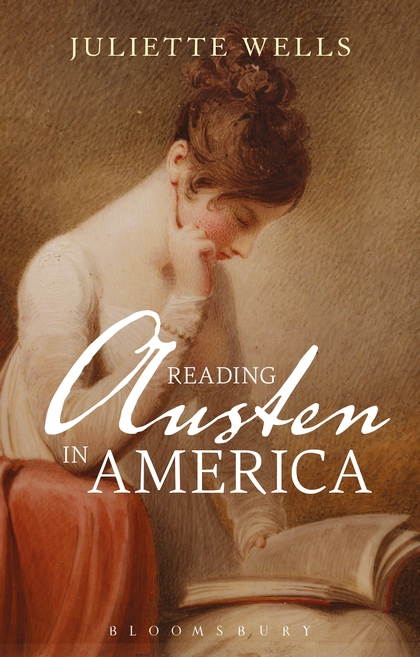Juliette Wells. Reading Austen in America. London: Bloomsbury Academic, 2017. 256 p. ill. ISBN 978-1350012042. $US68 hardcover, $US22.95 paper.
Juliette Wells’s Reading Austen in America considers Austen’s influence outside of Britain, and it serves as a prequel to her earlier book, Everybody’s Jane: Austen in the Popular Imagination (Bloomsbury, 2011). It complements other recent works such as Paula Byrne’s The Genius of Jane Austen (2017), Devoney Looser’s The Making of Jane Austen (2017), and Deidre Lynch’s Janeites: Austen’s Disciples and Devotees (2000).
The 1816 Philadelphia edition of Emma is the centerpiece of Wells’s study, serving both as its inspiration (Wells comes across a rare copy of this book in her own institution’s library) and as the focus of the first half of the book. Reading Austen begins with a discussion of the origins of the 1816 Philadelphia Emma, including circulation, comparison with the London edition, promotion, and impetus for publication. Wells then turns to case studies of three surviving copies of this rare edition–from the duPont sisters of Delaware, New Hampshire judge and governor Jeremiah Smith, and a Rhode Island circulating library. The last section demonstrates how Austen’s novels were read in nineteenth-century America by a Scotswoman, the Countess of Dalhousie, who lived in Halifax and Quebec.
Wells is especially adept at making these various readers come to life. In describing the copy of Emma in Jeremiah’s Smith’s library (now held by Dartmouth), she notes that Smith’s book is in much poorer shape than the other copies. Pages are detached from the stitching and appear to have been chewed, and evidence survives of an attempt at mending with a needle and thread. Wells blames these details on the “cheap production values” of the edition (65), but even so, the lived experience of this book is clear. Smith made many annotations in his book, including corrections of printers’ errors and underlining, and his notes about Austen’s life on the endsheets offer “the fullest evidence available of a devoted American reader of Austen before the 1830s” (73). Wells’s final case study of the 1816 Emma focuses on the copy held by James Hammond’s circulating library in Newport, Rhode Island. Wells recounts the marginalia of two different readers in this copy, including the humorous note that Emma is a “Silly Book” and “not worth reading whoever the author, as their time had better been spent in reading than inventing” (75). This reader also left a chart of judgments of characters, deeming Mr. Knightley “tolerable,” Emma “intolerable,” and Woodhouse as “grouty,” an Americanism for “sulky, cross, ill-tempered” (75-6).
The second half of Reading Austen comprises two chapters of “Transatlantic Austen Conversations.” The first concerns the new complete edition of Austen’s novels, published in Philadelphia in the early 1830s, and the Quincy sisters of Boston, who were passionate devotees of Austen and who carried on a transatlantic friendship with Austen’s brother, Admiral Sir Francis W. Austen. The final chapter of Reading Austen centers on correspondence between dedicated collector Alberta H. Burke of Baltimore and bibliographer David Gilson of Oxford. Burke and Gilson exchanged details about editions and translations of Austen’s novels, but also developed a deep friendship based on their shared experience as “uncredentialed, self-taught experts in Austen book history who were also enthusiasts” (188). It seems fitting to end this fascinating and compelling book with a discussion of the connections made across the Atlantic between these two vastly different individuals who were united by their shared enthusiasm for Austen’s novels.
Since this is a book about how real readers read, it is worth pointing out Wells’s address to her own readers. She notes that her aim is to write for “both academic and nonacademic readers,” so she keeps data and historical context to a minimum. The end result is an accessible book that will appeal to a wider range of readers from undergraduates to Janeites. An appendix of surviving copies of the 1816 Philadelphia Emma and eighteen illustrations further increase the appeal and usefulness of this important and accessible book.
Katherine Scheil, University of Minnesota


